
The Four Thirds System is a standard created by Olympus and Eastman Kodak for digital single-lens reflex camera (DSLR) and mirrorless camera design and development.

A digital single-lens reflex camera is a digital camera that combines the optics and the mechanisms of a single-lens reflex camera with a solid-state image sensor and digitally records the images from the sensor.
The Leica Digilux 1 is a digital camera developed in partnership with Panasonic, which was released in 2002, roughly the same time as the Canon PowerShot G2 and the Nikon 2000. It is the second of Leica's digital offerings. Where the original Digilux was developed in partnership with Fuji Camera, the Digilux 1 was developed jointly with Panasonic; Leica is responsible for optics, while Panasonic designs the camera electronics. According to Leica, this allows both companies to design cameras that creates a harmonious matching of lens to sensor to produce color and contrast to Leica standards.
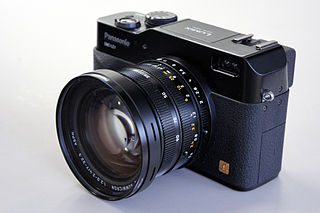
Lumix is Panasonic's brand of digital cameras, ranging from pocket point-and-shoot models to digital SLRs.

The Venus Engine is an image-processing engine for digital cameras. It is developed by the company Panasonic. Almost all of their Lumix cameras use a version of the Venus Engine. It is based on the Panasonic MN103/MN103S.

The Micro Four Thirds system is a standard released by Olympus and Panasonic in 2008, for the design and development of mirrorless interchangeable lens digital cameras, camcorders and lenses. Camera bodies are available from Blackmagic, DJI, JVC, Kodak, Olympus, Panasonic, Sharp, and Xiaomi. MFT lenses are produced by Cosina Voigtländer, DJI, Kowa, Kodak, Mitakon, Olympus, Panasonic, Samyang, Sharp, Sigma, SLR Magic, Tamron, Tokina, TTArtisan, Veydra, Xiaomi, Laowa, Yongnuo, Zonlai, Lensbaby, Venus Optics and 7artisans amongst others.

The Panasonic Lumix DMC-G1 was the first digital mirrorless interchangeable-lens camera (MILC) adhering to the Micro Four Thirds system design standard. The G1 camera is similar to the larger Four Thirds system format DSLR cameras, but replaces the complex optical path needed for the optical viewfinder with an electronic viewfinder EVF displaying a live view image directly from the sensor. Eliminating the mirror box and optical viewfinder allows for smaller and lighter camera bodies, while the less complex optical path also allows for smaller, lighter lens designs.

The Panasonic Lumix DMC-GH1 is a digital mirrorless interchangeable lens camera adhering to the Olympus and Panasonic developed Micro Four Thirds System (MFT) system design standard. Panasonic classified the GH1 as a hybrid stills/video camera and the GH1 was introduced and marketed as a higher end camera than Panasonic's first MFT camera, the stills only, non-video capable Lumix DMC-G1.

The Canon PowerShot S90 is a high-end 10.0-megapixel compact digital camera originally announced in 2009. The PowerShot S90 is the successor of the Canon PowerShot S80.
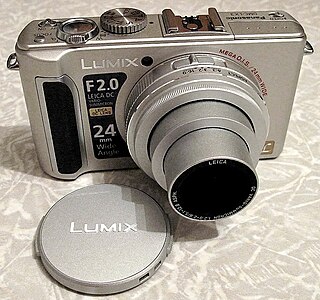
The Panasonic Lumix DMC-LX3, or LX3, is a high-end compact "point and shoot" camera launched by Panasonic in late 2008 to succeed the Lumix LX2.

The Canon PowerShot S95 is a high-end 10.0-megapixel compact digital camera announced and released in 2010. It was designed as the successor to the Canon PowerShot S90 in the S series of the Canon PowerShot line of cameras.
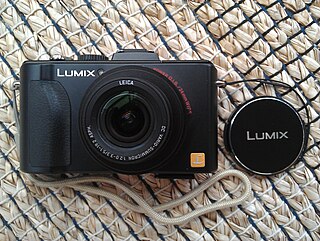
The Panasonic Lumix DMC-LX5, or LX5, is a high-end compact "point and shoot" camera launched by Panasonic in 2010 to succeed the LX3.
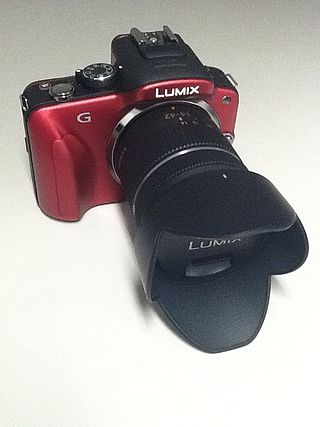
The Panasonic Lumix DMC-G3 is a digital mirrorless interchangeable lens camera adhering to the joint Olympus and Panasonic Micro Four Thirds System (MFT) system design standard. The Panasonic Lumix DMC-G3 is the eighth Panasonic MFT camera introduced under the standard and the thirteenth model MFT camera introduced by either Olympus or Panasonic, as of the G3 product announcement date.

The Panasonic Lumix DMC-G2 is a digital mirrorless interchangeable lens camera that adheres to the Micro Four Thirds System (MFT) design standard developed by Olympus and Panasonic. It was announced by Panasonic in March 2010 along with the Lumix DMC-G10. The G2 was introduced as the successor to the Lumix DMC-G1 camera, with upgrades such as 720p high-definition video recording capability in AVCHD Lite and Motion JPEG formats.
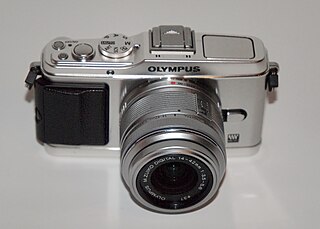
The Olympus PEN E-P3 announced on 30 June 2011 is Olympus Corporation's seventh camera that adheres to the Micro Four Thirds (MFT) system design standard. The E-P3 succeeds the Olympus PEN E-P2, and was announced in concert with two other models, the Olympus PEN E-PL3, and the Olympus PEN E-PM1.

Panasonic Lumix DMC-GF3 is the eighth camera in Panasonic's Lumix G-series adhering to the Micro Four Thirds System (MFT) design standard, and was announced in June 2011.

The Panasonic Lumix DMC-GH3 is a digital mirrorless interchangeable lens camera (MILC) manufactured by Panasonic. It is the successor to the Panasonic Lumix DMC-GH2 and was announced in September 2012 at photokina. It was available from November 2012.

The Panasonic Lumix DMC-LX7, or LX7, is a high-end compact "point and shoot" camera launched by Panasonic in 2012 to succeed the LX5.

The Panasonic Lumix DMC-GX7 announced in August 2013, is a Micro Four Thirds compact mirrorless interchangeable lens camera. It was Panasonic's first Micro Four Thirds camera with a built-in in-body stabilization system (IBIS) and has a built-in EVF. Panasonic uses 2-axis in-body stabilization allowing the use of shutter speeds 1 to 2 stops slower than without stabilization, compared to the 4 to 5 stops of improvement offered by Olympus' 5-axis stabilization.


















